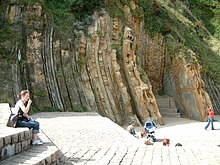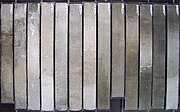Geologic record


The geologic record in
Correlating the rock record

At a certain locality on the Earth's surface, the rock column provides a
However using broadly occurring deposited layers trapped within differently located rock columns, geologists have pieced together a system of units covering most of the geologic time scale using the law of superposition, for where tectonic forces have uplifted one ridge newly subject to erosion and weathering in folding and faulting the strata, they have also created a nearby trough or structural basin region that lies at a relative lower elevation that can accumulate additional deposits. By comparing overall formations, geologic structures and local strata, calibrated by those layers which are widespread, a nearly complete geologic record has been constructed since the 17th century.
Discordant strata example

Correcting for discordancies can be done in a number of ways and utilizing a number of technologies or field research results from studies in other disciplines.
In this example, the study of layered rocks and the fossils they contain is called
The pictures of the fossils of monocellular algae in this USGS figure were taken with a scanning electron microscope and have been magnified 250 times.
In the U.S. state of
Comparing the record about the discordance in the record to the full rock column shows the non-occurrence of the missing species and that portion of the local rock record, from the early part of the middle Eocene is missing there. This is one form of discordancy and the means geologists use to compensate for local variations in the rock record. With the two remaining marker species it is possible to
| Segments of rock (strata) in chronostratigraphy | Time spans in geochronology | Notes to geochronological units |
|---|---|---|
| Eonothem | Eon | 4 total, half a billion years or more |
| Erathem | Era | 10 defined, several hundred million years |
| System | Period | 22 defined, tens to ~one hundred million years |
| Series | Epoch | 34 defined, tens of millions of years |
| Stage | Age | 99 defined, millions of years |
| Chronozone | Chron |
subdivision of an age, not used by the ICS timescale |
Lithology vs paleontology
Consequently, as the picture of the overall rock record emerged, and discontinuities and similarities in one place were cross-correlated to those in others, it became useful to subdivide the overall geologic record into a series of component sub-sections representing different sized groups of layers within known geologic time, from the shortest time span
Gallery
-
Well-eons of rock history through numerous wind and water exposed strata layers
-
New Orleans after Hurricane Katrina: Unlithified sediment layers laid down in historic times. This cut was an attempt to find bedrock near a residential street near the lower breach of the London Avenue Canal after restoring the levees which has been plowed/excavated clear by the Army Corps of Engineers, showing a nascent stratigraphy in the large deposits of silt deposited by flooding in recent earth history.
-
Three eras of deposition and two discordances are visible in this highway cut in the Netherlands. Note the color and slight angular change between the lower red bed layering and the middle strata. The upper strata are tilted yet again relative to the bottom layerings well demonstrating the cycles this land formation went through as part of the sea floor.
-
An ancient rockfall which protected the rock records beneath its impact site from further large scale erosion. Taken along Burr Trail, Grand Staircase–Escalante National Monument, Utah, US.
-
Sediment core, taken with a gravity corer by the research vessel POLARSTERN in the South Atlantic; light/dark-coloured changes are due to climatic variation of the Quaternary; basis age of the core is about 1 million years.
References
- ISBN 9780309095808)
{{citation}}: CS1 maint: multiple names: authors list (link - ^ Cohen, K.M.; Finney, S.; Gibbard, P.L. (2015), International Chronostratigraphic Chart (PDF), International Commission on Stratigraphy.






